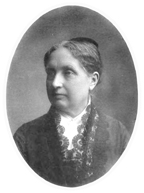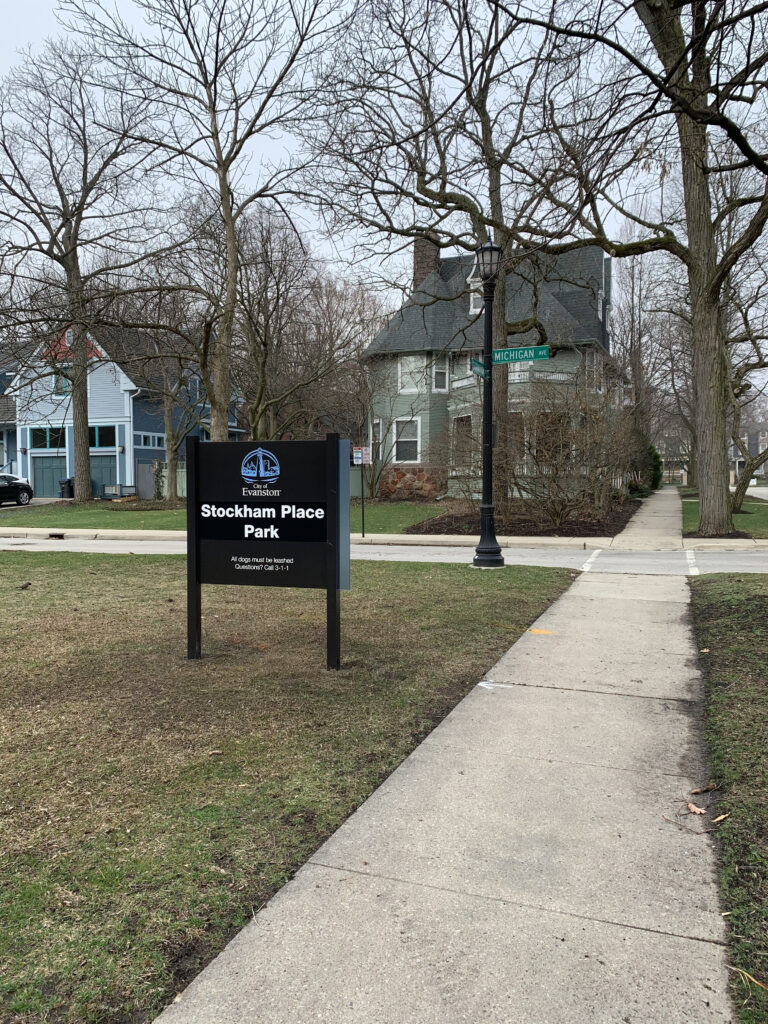The small park where Michigan Avenue ends at Burnham Place may be familiar to you – but it is likely that you did not know that it was named Stockham Place Park – or who the Park was named for – Alice Bunker Stockham. With a new sign in place, thanks to the City of Evanston Parks Department (with just a little prodding from the Evanston Women’s History Project), it is now more likely that her story will be more widely known. And what an important and interesting story it is…

Alice Bunker Stockham (1833-1912) was a physician, author, publisher, and women’s rights advocate. She was a pioneer in the field of women’s health and played a prominent role in this work both nationally and internationally. Stockham was ahead of her time in providing women access to basic medical information through her writings, and was a frank advocate for openness about female sexuality, at a time when this was the exception not the rule.
Stockham formed a publishing house to ensure that her works and the works of other reformers were widely available. She published several books and pamphlets as she believed that women should know how their bodies worked, including pregnancy, childbirth, diseases that only affect women, and menopause.
Alice, one of seven siblings, was born in Ohio in 1833 to Quaker parents who embraced Thompsonian medicine and hydropathy, treatments considered to be alternative healing practices by most Americans. This early exposure to alternative medicine solidified an interest for Alice in health and healing, and at the age of twenty, she enrolled at the Eclectic Medical College of Cincinnati. She embarked on a career specializing in the treatment of women and children in Kansas, Indiana and Chicago. Later she studied homeopathy at the Chicago Homeopathic College where received her medical degree in 1892, making her only the fifth woman in the U.S. to do so.
Stockham moved to Evanston in 1890 and her home became something of a community center for young girls and a social center for the community. She was revered by Evanston residents as one of its leading citizens and became involved in the suffrage movement and a wide range of reform activities.
Stockham published her first book, Tokology: A Book for Every Woman in 1883. Tokology presented straightforward discussions of the physiology of human reproduction. In 1894 she published a health manual for girls called Creative Life and it was during this time that her views of women’s access to reproductive information became controversial. Her writings were translated and published in German, French, Finnish and Swedish, and Russian author Leo Tolstoy was so impressed with her work that he arranged to have it translated into Russian.
By the mid 1890’s Stockham was internationally known as a woman with modern views and the courage to inform and educate the masses despite facing critics for speaking about issues which had been considered private and not for public discussion.
In 1905 when Stockham was in her seventies, the Society for the Suppression of Vice accused her, under the Comstock Law, of sending improper matter through the mails. She hired a lawyer (prominent Chicago attorney Clarence Darrow) and the case went to trial. Stockham was found guilty and fined $250 dollars. Her books were banned, forcing her publishing company and her school in Wisconsin to close. She never recovered from the trial and moved to California with her daughter where she continued to practice mental healing but ceased all writings.
Alice Bunker Stockham died in California in 1912 at the age of seventy nine.

Stockham lived in Evanston from 1890 until 1910. In July 1890 she purchased what was the Edwin Brown Estate and subdivided the land for development. Stockham retained one parcel for herself and hired prominent Chicago architect firm Baumann and Cady to design and build her home. It still stands at 222 Burnham Place. She lived in the house only until 1894 – it is not clear why she moved. Her second home in Evanston was at 921 Ridge Avenue.
When Stockham subdivided the Brown estate, the original double drive running north and south was maintained and the new street was named Stockham Place Park with the parkway in the middle. It became the northern end of Michigan Avenue in 1892, but the parkway itself retained the name Stockham Place Park. To add to the naming confusion, the street running east and west on the northern end of the estate was named Stockham Place in 1892.
In 1924, after the death of architect Daniel Burnham in 1912, a final street name change took place: Stockham Place became Burnham Place. Daniel Burnham’s estate was located north of Stockham Place and ran the full block from Forest Avenue to the Lake. The name change honored Burnham’s long residence in Evanston and his prominence as an architect and urban planner. The name change also followed Stockham’s trial, fall from grace, and death – and it could be that her loss of prominence also prompted the change.
The park’s name was never changed. As far as our records show – the park has been named Stockham Place Park since the original subdivision of the land in 1890. It just was without a sign for so many years.
We are so glad to share this story – and hope that the new sign at the park encourages others to explore!
Evanston has quite a few places and parks named for women. The EWHP is currently working with the City of Evanston Parks and Recreation Department to create a resource to tell all of their stories. Stay tuned for more by March 2022!
Sources:
Research assistance from Julia Flynn and Kris Hartzell
Mary Baker Eddy Library
